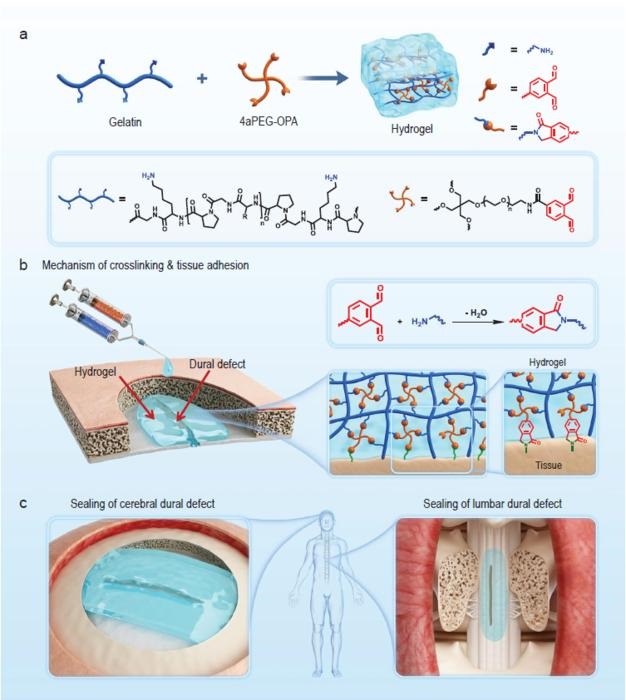New Hydrogel Sealant Effective at Sealing Dural Defects and Preventing Postoperative Adhesion
|
By HospiMedica International staff writers Posted on 31 May 2024 |

The dura mater is a fibrous membrane of connective tissue that envelops the brain and spinal cord. In neurosurgical procedures that require access to the brain or spinal cord, opening the dura mater often leads to complications, one of which is the leakage of cerebrospinal fluid (CSF). CSF leakage can result in a variety of severe complications, including postural headaches, pseudodural cysts, dural fistulas, cerebral or spinal hernias, meningitis, intracranial hemorrhages, epidural fibrosis, and postoperative adhesions. To address this, the standard clinical practice involves suturing the area where the dura mater has been opened. However, suturing can be time-consuming and challenging, particularly when dealing with hard-to-reach defects. The process also damages the dura mater, and the needle holes can hinder the achievement of a watertight seal. Consequently, there has been significant interest in developing tissue adhesives and sealants that can provide sutureless wound closure, achieve hemostasis, and seal against leaks more effectively, offering benefits like ease of use, reduced tissue damage, and suitability for urgent medical situations.
Scientists at the Chinese Academy of Sciences (Beijing, China) have developed an innovative injectable hydrogel sealant that is tissue-adhesive and exhibits minimal swelling. This sealant, based on o-phthalaldehyde (OPA)/amine chemistry, is designed specifically for dural sealing and repair. The hydrogel forms when gelatin is mixed with OPA-terminated 4-armed PEG (4aPEG-OPA). In this reaction, the OPA groups from the 4aPEG-OPA react with the amine groups in the gelatin, forming phthalimidine linkages that create a stable, low-swelling cross-linking network. Additionally, the OPA groups can also bond with amine groups on the tissue surface, enhancing the hydrogel’s adhesion to the tissue and ensuring a watertight seal over the dural defects. The adhesive strength of this 4aPEG-OPA/gelatin hydrogel on porcine tissue has shown to be significantly stronger than that of fibrin glue, and its ability to withstand pressure exceeds that of postoperative CSF pressure fluctuations.
Further evaluations, including in vitro swelling and degradation tests, have demonstrated that the 4aPEG-OPA/gelatin hydrogel has a considerably lower swelling ratio compared to other commercially available dural sealants. In vivo studies using rat and rabbit models have shown that when applied to lumbar and cerebral dural incisions, the hydrogel effectively seals the defects and prevents CSF leakage without exerting undue pressure on the central nervous system. Additionally, the use of this hydrogel has been associated with reduced local inflammation, decreased epidural fibrosis, and fewer postoperative adhesions in the areas of the dural defect. These findings highlight the significant potential of the 4aPEG-OPA/gelatin hydrogel as a multifunctional sealant for effectively sealing dural defects and preventing postoperative complications.
Related Links:
Chinese Academy of Sciences
Latest Surgical Techniques News
- Bioprinted Aortas Offer New Hope for Vascular Repair
- Early TAVR Intervention Reduces Cardiovascular Events in Asymptomatic Aortic Stenosis Patients
- New Procedure Found Safe and Effective for Patients Undergoing Transcatheter Mitral Valve Replacement
- No-Touch Vein Harvesting Reduces Graft Failure Risk for Heart Bypass Patients
- DNA Origami Improves Imaging of Dense Pancreatic Tissue for Cancer Detection and Treatment
- Pioneering Sutureless Coronary Bypass Technology to Eliminate Open-Chest Procedures
- Intravascular Imaging for Guiding Stent Implantation Ensures Safer Stenting Procedures
- World's First AI Surgical Guidance Platform Allows Surgeons to Measure Success in Real-Time
- AI-Generated Synthetic Scarred Hearts Aid Atrial Fibrillation Treatment
- New Class of Bioadhesives to Connect Human Tissues to Long-Term Medical Implants
- New Transcatheter Valve Found Safe and Effective for Treating Aortic Regurgitation
- Minimally Invasive Valve Repair Reduces Hospitalizations in Severe Tricuspid Regurgitation Patients
- Tiny Robotic Tools Powered by Magnetic Fields to Enable Minimally Invasive Brain Surgery
- Magnetic Tweezers Make Robotic Surgery Safer and More Precise
- AI-Powered Surgical Planning Tool Improves Pre-Op Planning
- Novel Sensing System Restores Missing Sense of Touch in Minimally Invasive Surgery
Channels
Critical Care
view channel
Mechanosensing-Based Approach Offers Promising Strategy to Treat Cardiovascular Fibrosis
Cardiac fibrosis, which involves the stiffening and scarring of heart tissue, is a fundamental feature of nearly every type of heart disease, from acute ischemic injuries to genetic cardiomyopathies.... Read more
AI Interpretability Tool for Photographed ECG Images Offers Pixel-Level Precision
The electrocardiogram (ECG) is a crucial diagnostic tool in modern medicine, used to detect heart conditions such as arrhythmias and structural abnormalities. Every year, millions of ECGs are performed... Read morePatient Care
view channel
Portable Biosensor Platform to Reduce Hospital-Acquired Infections
Approximately 4 million patients in the European Union acquire healthcare-associated infections (HAIs) or nosocomial infections each year, with around 37,000 deaths directly resulting from these infections,... Read moreFirst-Of-Its-Kind Portable Germicidal Light Technology Disinfects High-Touch Clinical Surfaces in Seconds
Reducing healthcare-acquired infections (HAIs) remains a pressing issue within global healthcare systems. In the United States alone, 1.7 million patients contract HAIs annually, leading to approximately... Read more
Surgical Capacity Optimization Solution Helps Hospitals Boost OR Utilization
An innovative solution has the capability to transform surgical capacity utilization by targeting the root cause of surgical block time inefficiencies. Fujitsu Limited’s (Tokyo, Japan) Surgical Capacity... Read more
Game-Changing Innovation in Surgical Instrument Sterilization Significantly Improves OR Throughput
A groundbreaking innovation enables hospitals to significantly improve instrument processing time and throughput in operating rooms (ORs) and sterile processing departments. Turbett Surgical, Inc.... Read moreHealth IT
view channel
Printable Molecule-Selective Nanoparticles Enable Mass Production of Wearable Biosensors
The future of medicine is likely to focus on the personalization of healthcare—understanding exactly what an individual requires and delivering the appropriate combination of nutrients, metabolites, and... Read more
Smartwatches Could Detect Congestive Heart Failure
Diagnosing congestive heart failure (CHF) typically requires expensive and time-consuming imaging techniques like echocardiography, also known as cardiac ultrasound. Previously, detecting CHF by analyzing... Read moreBusiness
view channel
Expanded Collaboration to Transform OR Technology Through AI and Automation
The expansion of an existing collaboration between three leading companies aims to develop artificial intelligence (AI)-driven solutions for smart operating rooms with sophisticated monitoring and automation.... Read more

















